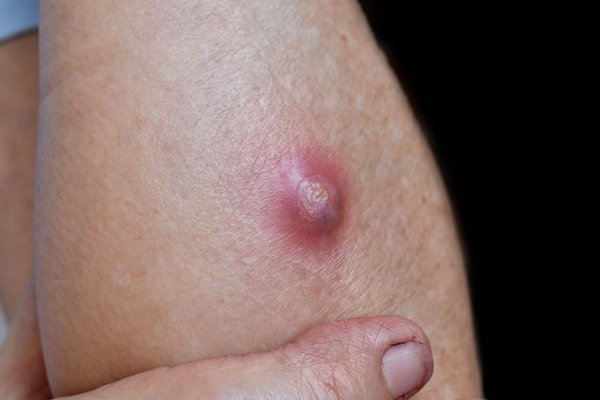Skin abscesses, often recognized as swollen, painful lumps filled with pus, are a common type of infection that affects the skin and underlying tissue. These localized infections can occur anywhere on the body, but are frequently found on areas exposed to friction, hair follicles, or minor skin trauma — such as the neck, back, underarms, or thighs.
In this article, we provide an in-depth, fact-based look at what causes abscesses, how they develop, treatment options, and when to seek medical help, drawing on sources like the National Health Service (NHS), Mayo Clinic, and the Centers for Disease Control and Prevention (CDC).
What Is a Skin Abscess?
A skin abscess is a collection of pus that forms within the dermis (the deep layer of skin) or underlying tissue as a response to infection. Pus is composed of white blood cells, bacteria, and dead skin cells. The immune system forms this pocket as it attempts to isolate and neutralize harmful microbes.
According to the NHS, abscesses are typically caused by bacterial infections, with Staphylococcus aureus being the most common culprit. When bacteria enter through a hair follicle, small cut, or blocked oil gland, the body responds by sending white blood cells to fight the infection, leading to inflammation and pus accumulation.
Sources:
- NHS – Abscesses
- Mayo Clinic – Skin Abscess

Causes and Risk Factors
Common causes of skin abscesses include:
- Bacterial infection: Primarily due to Staphylococcus aureus, including methicillin-resistant strains (MRSA).
- Poor hygiene or skin trauma: Minor cuts or abrasions that are not cleaned properly can lead to bacterial entry.
- Blocked sebaceous (oil) glands or sweat glands.
- Ingrown hairs or shaving irritation, especially in areas like the face or neck.
- Immune system compromise: Conditions such as diabetes, cancer treatment, or chronic steroid use may increase susceptibility.
People who frequently shave or experience skin friction (e.g., athletes, manual laborers) are also at increased risk.
Sources:
- CDC – MRSA and Skin Infections
- American Academy of Dermatology (AAD)

Symptoms of a Skin Abscess
An abscess typically presents as:
- A swollen, firm, red lump that may feel warm or painful to the touch.
- Accumulation of pus, giving it a soft center or fluctuant feel.
- Skin stretching or shiny appearance over the affected area.
- Occasional fever or fatigue if the infection is spreading or severe.
In rare cases, abscesses may rupture spontaneously, draining pus externally. However, self-treatment or squeezing abscesses without medical supervision can lead to complications, such as deep tissue infection or bacteremia (spread of bacteria in the bloodstream).
Source:
- Mayo Clinic – Abscess Complications

Diagnosis and Medical Evaluation
A skin abscess can often be diagnosed through physical examination by a healthcare provider. In cases where the abscess is large, recurring, or does not respond to initial treatment, a doctor may order:
- Culture tests to identify the type of bacteria.
- Ultrasound imaging to assess the size and depth.
- Blood tests if systemic infection is suspected.
Important Note: If a lump is located on the neck, as in the example shown, further diagnostic workup is often recommended to rule out lymph node involvement, sebaceous cysts, or other structural causes.
Sources:
- Cleveland Clinic – Skin Abscess Evaluation

Treatment Options
Treatment depends on the size and severity of the abscess:
1. Warm Compresses
For small abscesses, applying warm compresses several times a day can help stimulate drainage. Over-the-counter pain relievers such as acetaminophen or ibuprofen can reduce discomfort.
2. Incision and Drainage
For moderate to large abscesses, a minor surgical procedure called incision and drainage (I&D) may be performed. This involves:
- Cleaning the skin with antiseptic.
- Making a small incision to release the pus.
- Sometimes placing a sterile dressing or drain.
This procedure is typically done in an outpatient setting and provides immediate relief from pressure.
3. Antibiotics
Not all abscesses require antibiotics, but they may be prescribed if:
- The abscess is accompanied by fever.
- There are multiple abscesses or cellulitis (skin infection).
- The patient has a weakened immune system.
Source:
- UpToDate – Abscess Management
When to Seek Medical Attention
It’s important to consult a healthcare provider if:
- The abscess is larger than 1 cm in diameter.
- There is fever, chills, or spreading redness.
- The area is located on the face, neck, spine, or groin.
- There are signs of systemic illness or recurring infections.
Self-treatment without sterile tools or proper aftercare may lead to scarring, secondary infection, or even sepsis, a potentially life-threatening complication.
Source:
- World Health Organization – Safe Skin Care Practices

Preventing Future Abscesses
To reduce the risk of developing skin abscesses:
- Maintain good hygiene and wash hands regularly.
- Treat minor skin injuries with antiseptic promptly.
- Avoid sharing razors, towels, or personal care products.
- Use clean, sharp razors and avoid shaving over irritated skin.
- If prone to recurrent infections, speak to a doctor about underlying causes.
Sources:
- American Academy of Family Physicians (AAFP)
- NHS – Skin Infection Prevention
Conclusion
Skin abscesses, while common and often treatable, can become serious if left unattended or improperly managed. If you notice a painful lump, particularly one growing in size or causing discomfort, it is essential to seek evaluation from a licensed healthcare provider. Early intervention helps prevent complications and speeds up recovery.
The image shown appears consistent with a large abscess or inflamed cyst, but only a licensed professional can provide an accurate diagnosis. Avoid attempting to self-drain or treat such lesions at home, especially on delicate areas like the neck.
Verified Medical Sources:
- NHS UK: https://www.nhs.uk/conditions/abscess/
- CDC – MRSA Information: https://www.cdc.gov/mrsa
- Mayo Clinic – Abscess Treatment Guide: https://www.mayoclinic.org
- Cleveland Clinic: https://my.clevelandclinic.org
- World Health Organization – Infection Control: https://www.who.int
